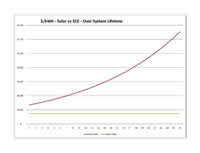Welcome to the
Run on Sun Monthly Newsletter

In this Issue: |
August, 2010
Volume: 1 Issue: 8
State of Solar in California - Annual CSI Program Assessment Reveals a Strong Demand for SolarThree years into an ambitious ten year plan to install 3,000 MW of solar power on California rooftops, the State of Solar in California is surprisingly good - despite a difficult economy. The California Solar Initiative covers that portion of the program under the auspices of the California Public Utilities Commission (CPUC) and involves the three Investor-Owned Utilities in the state - PG&E, SCE and SDG& E. The CPUC recently issued its Annual Program Assessment. The CSI program, which is targeted to install some 1,940 MW of solar by the end of 2016 is already 42% of the way there. The Assessment has loads of interesting statistics and it is worth at least skimming the 91 page report. Among the key findings:
It would be nice to see similar analysis coming from the Muni's - which up until now tend to keep their data to themselves. |
Although demand for solar remains strong, financial impediments still remain.
Next month we will
feature another in our continuing series of updates on the
PACE/AB 811 financing program in Los Angeles County (known as LACEP).
Will LACEP become a viable funding source for potential solar customers anytime soon?
Solar Charged Driving Profiles Run on SunThe great website, Solar Charged Driving, features a wealth of information about the synergy between solar power and electric vehicles - whether fully electric (EVs) like the Nissan Leaf or plug-in hybrids (PHEVs) like the Chevy Volt. We have been following the site for quite awhile and have learned a lot about upcoming vehicles and the issues associated with their development (such as the debate over adding sound generators so that blind people will know when the vehicles are moving). If you are interested in EVs and particularly fueling them via solar power, this website is a must read (and their RSS feed makes it easy to follow their posts). So we were thrilled when the Founder & Editor of SolarChargedDriving.com, Christof Demont-Heinrich, contacted us for an interview about our efforts to cross-market solar power systems with this next generation of EVs. The result is a wonderful article that is now up on the web, aptly titled: "He wants your next car to Run on Sun." So true! Please check it out, and if you like what you see, please add a comment and share it with your social network. We have also been asked to provide some articles of our own from time-to-time as a "guest blogger". You can read our first article about how the recent pricing announcement for the Chevy Volt drove a definite spike in consumer interest in learning more about the car, here. |
Corporations are Hoarding Money…
|

